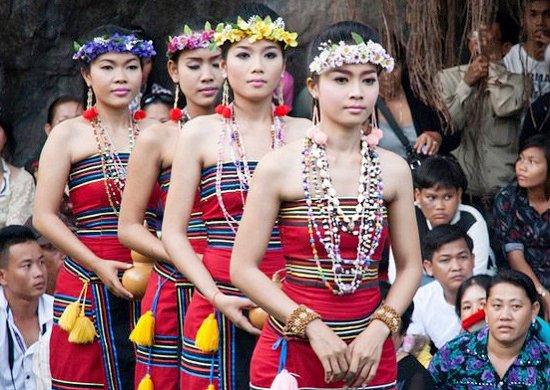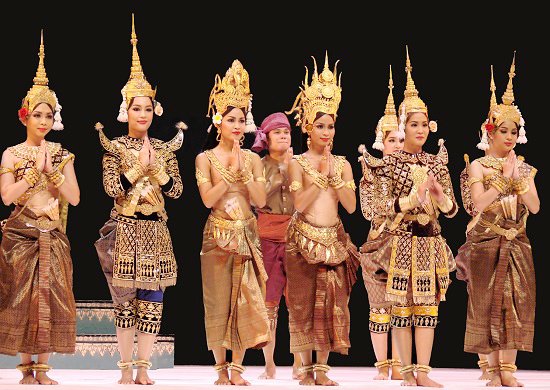Cambodia #23: Khmer People

Khmer people are a Southeast Asian ethnic group native to Cambodia, representing around 97% of the country's 16 million people.
Around 90-95 percent of the population is Khmer ethnic. The rest of the 5-10 percent incorporates -Khmer- Chinese, Khmer Islam or Chams, hill-tribe people, known as the Khmer Loeu, and Vietnamese. Around 10 percent of the people live in Phnom Penh capital, making Cambodia largely a country of rural dwellers, farmers and artisans.
The ethnic groups that constitute Cambodian culture have various monetary and demographic commonalties. Chinese dealers lived mainly in urban centers and play middlemen in numerous financial cycles, yet they likewise preserve differences in their social and cultural institutions. They were concentrated for the most part in focal and in southeastern Cambodia, the real contrasts among these groups lie in social association, language and religion.
Most of the occupants of Cambodia are settled in genuinely permanent villages close to the significant bodies of water in the Tonle Sap Basin-Mekong Lowlands region. The Khmer Loeu lives in broadly scattered villages that are surrendered when the cultivated land in the region is exhausted. The permanently settled Khmer and Cham villages typically situated on or close to the banks of a river or different bodies of water. Cham villages generally are made up almost totally of Cham, however Khmer villages particularly in focal and in southeastern of Cambodia, ordinarily incorporate sizable Chinese people group.

The Khmer Loeu
The Khmer Loeu are the non-Khmer highland tribes in Cambodia. The Khmer Loeu are discovered specifically in the northeastern territories of Rattanakiri, Stung Treng, Mondulkiri and Kratie provinces. Most Khmer Loeu live in scattered temporary villages that have just a few hundred occupants. These villages generally are governed by a council of local elders or by a village headman.
The Khmer Loeu cultivate a wide variety of plants, but the man crop is dry or upland rice growth by the slash-and-burn method. Hunting, fishing, and gathering supplement the cultivated vegetable foods in the Khmer Loeu diet.
Houses are different from large multi-family long houses to small single family structures. They might be constructed near the ground or on stilts. The significant Khmer Loeu groups in Cambodia are the Kuy, Phnong, Brao, Jarai, and Rade. Everything except around 160,000 Kuy lived in the northern Cambodia provinces of Kampong Thom, Preah Vihear, and Stoeng and additionally in adjoining Thailand.
The Chinese
The Chinese in Cambodia formed the country. Around 60 percent of the Chinese were urban dwellers engaged mainly in commerce; the other 40 percent were rural residents working as shopkeepers, as purchasers and processors of rice, palm sugar, natural fruit, and fish and as money lenders.
It is evaluated that 90 percent of the Chinese in Cambodia were in business and that 92 percent of those engaged with commerce in Cambodia were Chinese. In rural Cambodia, the Chinese were moneylenders, and they wielded considerable economic power over the ethnic Khmer laborers through usury.
The Chinese in Cambodia represented five major linguistic groups, the biggest of which was the Teachiu (around 60 percent), followed by the Cantonese (around 20 percent), the Hokkien (around 7 percent), and the Hakka and the Hainanese (each 4 percent). Those belonging to the specific Chinese linguistic groups in Cambodia had a tendency to gravitate toward specific occupations.
The Teachiu, who make up around 90 percent of the rural Chinese population, ran village stores, control rural credit and rice marketing facilities, and grew vegetables. In urban regions they were frequently occupied with so many ventures as the import-trade business, the sale of pharmaceuticals, and street peddling. The Cantonese, who were the greater part of Chinese groups before Teachiu migrations started in the late 1930s, live for the most part in the city. Ordinarily, the Cantonese participates in transportation and in constriction, generally as mechanics or carpenters.
The Hokkien people group was involved import- export and in banking, and it incorporated some of the country’s richest Chinese. The Hainanese began as pepper producers in Kompot Province, where they continued to dominate that business. Many people moved to Phnom Penh where they reportedly had virtual monopoly on the hotel and restaurant business. They likewise frequently worked tailor shops. In Phnom Penh, the recently arrived Hakka were regularly dental specialists, dealers of traditional Chinese medicines, and shoemakers.
The Cham
The Cham people in Cambodia descend from refugees of the Kingdom of Champa, which one controlled much of Vietnam between Gao Ha in the north and Bien Hao in the south.
The Khmer Chams are partitioned into two groups, the orthodox and the traditional- base on their religious practices. The orthodox group, which make up around 35% of the total number of Chams in the country, were situated primarily in Phnom Penh - Oudong territory and in the provinces of Takeo and Kapot.
The traditional Chams were scattered all through the middle section of the country in the provinces of Battambang, Kompong Thom, Kompong Cham, and Pursat. The Chams of the two groups commonly live in villages occupied just by other Chams; the villages might be along the shores of waterway, or they might be inland. The occupants of the river villages take part in fishing and growing vegetables. They exchange fish to local Khmer for rice.
The ladies in these villages earn money by weaving. The Chams who live inland help themselves by different means, depending on the villages. A few villages are good at metalworking; others raise natural fruit trees or vegetables. The Chams additionally regularly serve as butchers of cows for their Khmer Buddhist neighbors and are, in a few territories, regarded as skillful water buffalo and ram breeders.
The Vietnamese
The Vietnamese people group is scattered all through southeastern and focal Cambodia. They were gathered in Phnom Penh, and in Kandal, Prey Veng, and Kampong Cham provinces. No close cultural or religious ties exist amongst Cambodia and Vietnam.
The Vietnamese fall inside the Chinese culture sphere, rather inside the Indian, where the Thai and Khmer have a place. The Vietnamese vary from the Khmer in method of dress, in family relationship organization, and in numerous different routes for instance the Vietnamese are Mahayama Buddhists while a large portion of the Cambodians are Theravada Buddhists. Although Vietnamese lived in urban centers, for example, Phnom Penh, a generous number lived along the lower Mekong and Bassac rivers and in addition on the shores of the Tonle Sap, where they occupied with fishing.

Thank you for sharing! Upvoted
Thanks for enjoying my post and gave an upvote.
It's really interesting how various ethnic groups perform certain tasks or trades. That used to be the case in New Zealand, but is becoming less common than it used to be. Nowadays people tend to do what interests them, rather than what their culture does.
Thanks for sharing about various ethnic groups in New Zealand.
Thank you for sharing , as always, I love reading your precious blog, regards!
Thanks for love reading my blog.
Good post @chantha
Thanks for enjoying this post.
@chantha got you a $1.4 @minnowbooster upgoat, nice! (Image: pixabay.com)
Want a boost? Click here to read more!